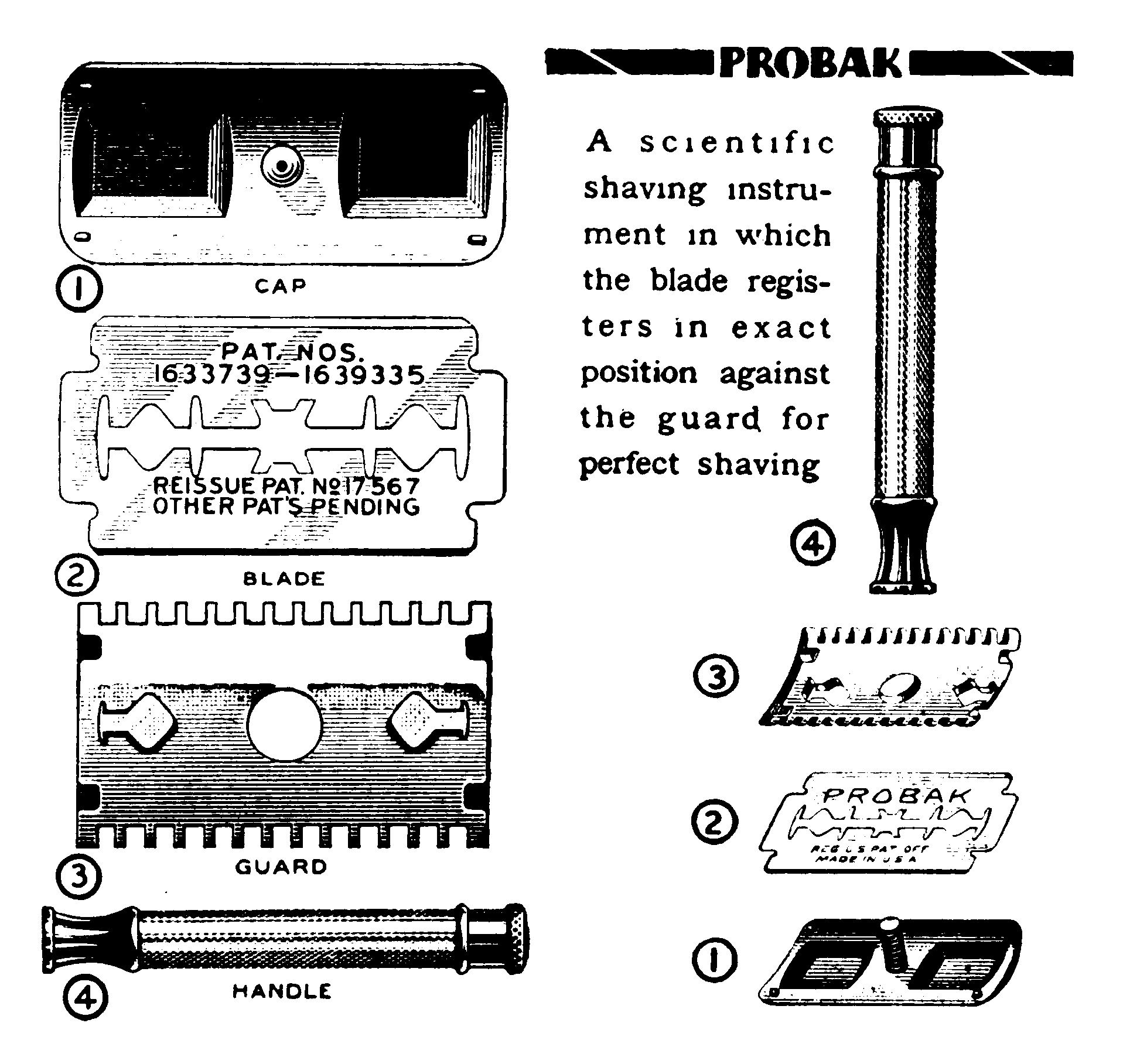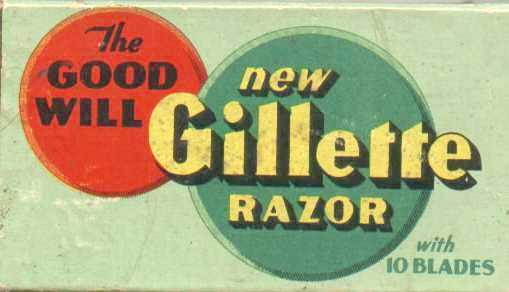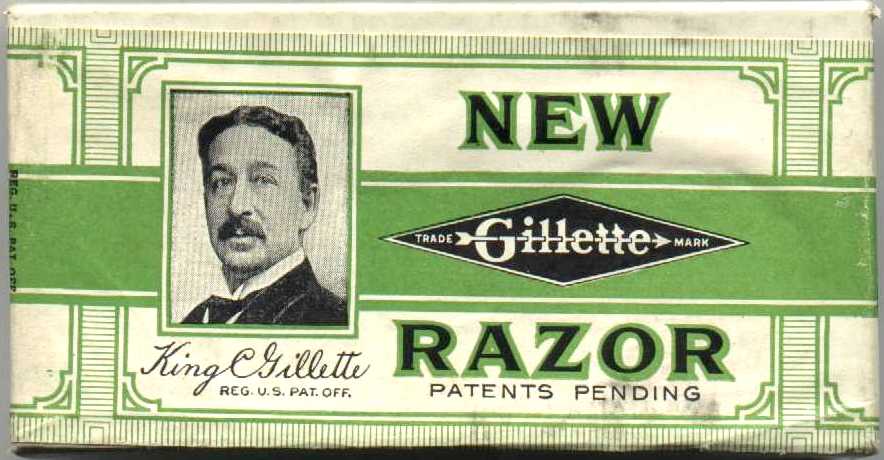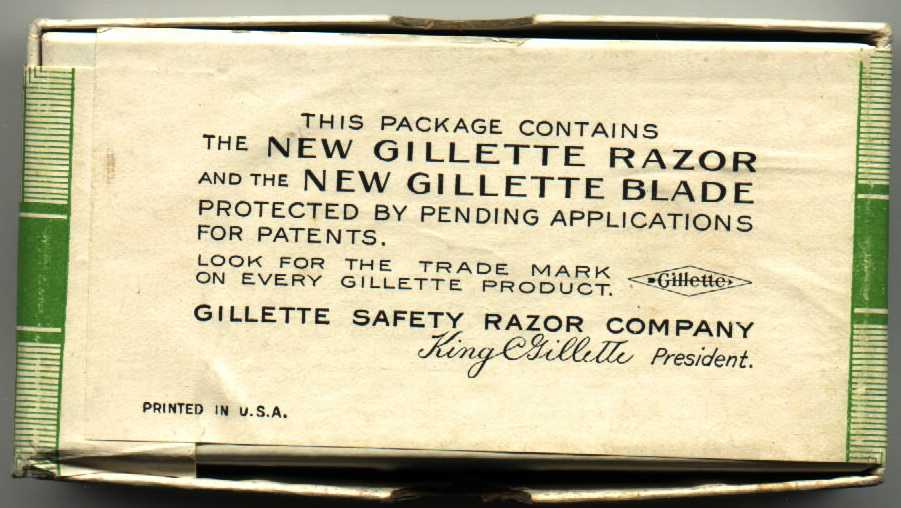AS A pre-teen, I wondered why my Dad's double edge razor blades had that weird shape. Was it simply an artistic design or was there some rational reason? Other more interesting curiosities soon caught my attention and I forgot about the blade puzzle. I discovered the answer only after I became addicted to safety razor collecting. It turned out that the strange blade design was neither artistic nor rational. It was the outcome of a 1930 patent battle between the Gillette Company and an inventor named Henry J. Gaisman.
The story begins with the first 1904 Gillette patents that covered a safety razor and a unique double-edge throw-away blade that was so thin that it was flexible.The 1906 Gillette blade looked like this:

The razor had a cap with a threaded stem and two studs that aligned with the three holes in the blade. The illustration below is from a 1905 Gillette advertisement. The threaded stem on the cap engaged the inner handle. Rotating the end of the handle clamped the guard , the blade, and the cap together in a neat sandwich. A slight twist of the handle could e
xpose more or less of the blade edge as the cap sqeezed the flexible blade against the guard. The original 1903 three-hole blade design didn't change for 25 years. Then it went crazy.
In May 1921 Gillette introduced the NEW IMPROVED Gillette razor and blade. When the original Gillette patents expired in November 1921, competitors were free to manufacturer and sell blades that fit the nearly 15 million Gillette razors that had sold by then. Gillette kept the original three-hole blade design, and launched a major advertising campaign that emphasized the superior quality of their blades over competitive imitations.
In 1928 Henry J. Gaisman founded the Probak Corp. as a division of his AutoStrop Safety Razor Co. Probak started to manufacture razors and blades similar to Gillette's. Probak blades would work in both Probak and Gillette razors. Probak razors, however, would not accept Gillette blades. Instead of having round pins in the cap, the razors had a pair of depressions that accepted the variously shaped studs that were on the guard. There were eight different guard designs with differently shaped studs. In addition, the cap had corner blade-alignment pins that nested into depressions in the guard. The blade, in order to fit, had to have correctly placed openings to accept the protrusions and the corner pins. A similar scheme had been used in the 1920s by Gaisman's AutoStrop Company in a vain attempt to prevent competitors from making a blade that would fit the AutoStrop Valet single-edge razor.
 Meanwhile (1929-1930), the Gillette Safety Razor Company was working on a similar razor and blade combination. The old three-hole blades would not fit in the new NEW GILLETTE, but the new, patented, slotted blade would still work in all the old Gillette razors. The outcome was a patent fight that ended up with Gillette buying the AutoStrop Co.
Meanwhile (1929-1930), the Gillette Safety Razor Company was working on a similar razor and blade combination. The old three-hole blades would not fit in the new NEW GILLETTE, but the new, patented, slotted blade would still work in all the old Gillette razors. The outcome was a patent fight that ended up with Gillette buying the AutoStrop Co.Many creative cap and guard designs were made in the 1930s by Gillette and Probak (by then a division of Gillette). The Gillette variations were dubbed Goodwill razors and they gave away 3 million of them free when you bought a $1 package of 10 New Gillette blades. (See The Complete Gillette Collector's Handbook, by Phillip L. Krumholz, pages 307, 402-404, and 234-240.)


 The Goodwill Razor NEW GILLETTE razor "PROTECTED BY PENDING APPLICATIONS FOR PATENTS."
The Goodwill Razor NEW GILLETTE razor "PROTECTED BY PENDING APPLICATIONS FOR PATENTS."

Before 1921
Thin guard,
Style 1021921-29
Thick guard,
Style 102A1921-1929
"New Improved"
Style 1341931
Standard "Goodwill"
Style 160One of several variants
1928-29
"New Gillette"
Style 1261939 "Tech" 
Gillette vs. Probak Timeline
1928 April 1929 Nov. 1929 Dec. 1929 Mar 1930 May 1930 July 1930 Oct. 1930 Probak
Company
formed.NEW GILLETTE patent filed (3-hole blade). Probak blade Trademarks filed. Probak razor patent filed – includes slotted blade. New Gillette Razor announced.
Gillette slotted blade patent filed.
Revised Gaisman (Probak) patent
filed.NEW GILLETTE patent filed (slotted blade). Merger of Gillette and AutoStrop. Blade Evolution
The original.
Long slot and square, indented corners.
Added two
transverse slots.
Added four
transverse slots.
Added corner indents. One shape fits all.1904-1928 1929 1931 1932 1933 Example Blade Packages - 1904-1946
Dates determined from date code on blade
1949 1953 1958 1959-1960 1967 and 1968 (sample)
The first blade wrapper was black and white and there was no inner wax-paper wrapper. The famous green package with King C. Gillette's portrait first appeared in mid-1906 and subliminally reminded one of U.S. currency. This "banknote" design lasted until the depression. The New Gillette blade had a long slot instead of three holes. The rust-resistant oxidized Blue Blade was introduced in April of 1932. In the late '30s the Thin Blade with a brown surface finish had a red wrapper that was missing the Gillette visage. The Super Blue blade came out in the late '60s and KCG's picture shrank to insignificance and then disappeared altogether. Around 1948 Blue Blades began to be packaged in double-ended plastic dispensers. The blades were marked with arrows to indicate which way the blade was to be pushed to slide it from the dispenser. Blades that were sold in the traditional packages in the early 1950s may or may not have had the arrows. In the mid-60s competition from Wilkinson Sword of England forced Gillette to go stainless.
For a chart (PDF file) for decoding Gillette razor and blade date codes click here.
For Alan Appleby's guide to identifying vintage Schick razors click here.Although his name never became a household word as did King C. Gillette's, Henry J. (for Jacques) Gaisman also was a pioneer safety razor inventor and entrepreneur. He was 14 years younger than King Gillette but he obtained his first two safety razor U.S. patents in May and July of 1904, several months ahead of Gillette's famous patents. He was awarded the first patent for a safety razor that allowed stropping of the blade while it was still in the razor. Henry J. Gaisman vs. The Gillette Company
Gaisman founded the AutoStrop Company and the first AutoStrop razors were sold in 1906. By 1920 Gaisman had dozens of razor-related patents. One of his non-razor inventions had also paid off. In 1914, his friend, George Eastman, paid him $300,000 for his patent for a method of writing on film while it was still in the camera. Thus was born the Kodak Autographic cameras.
Business Week magazine of Nov. 26, 1930 described Henry Gaisman as "... of medium height, of benign mien. He lives in a Park Avenue apartment in a state of contented batchelorhood. ... He has voiced doubts as to whether any woman could live with him. The doubt applies to unconventional working habits and not to personal disposition. If he gets an idea in the middle of the night there is no more sleep for him. Like Gillette, Gaisman is an incurable inventor. Also like Gillette, Gaisman possesses a quality notoriously lacking in most inventors– shrewd executive ability."
The showdown between Gaisman and the Gillette Company came in 1930. The story is well told by Russell Adams in his book, King C. Gillette (Little, Brown, 1978) and in the pages of Business Week magazine during the fall of 1930, but it is worth summarizing here. In January of 1930, AutoStrop and Gaisman's two-year old Probak Company had been granted a patent and trademarks on several razor blade slot designs. One of which was identical to the New Gillette blades (marked PATENTS PENDING) that were introduced the next month. AutoStrop threaten to sue and the Gillette Company charged that Gaisman had swiped their ideas. By the end of the year Gaisman had marketed Probak razors and blades bearing three separate patent numbers. Probak was a made-up name ( inspired, perhaps, by Kodak? ), and reportedly was chosen by AutoStrop because it was likely to be pronounced the same in any language.
Jan. 7, 1930, filed Nov. 25, 1929.
Bottom: Gillette's Patent –
Aug. 5, 1930, filed Mar. 19, 1930.Gillette decided that it would be easier to buy the AutoStrop Company rather than fight them in the courts. Finally, in November of 1930, AutoStrop merged with Gillette. Henry Gaisman emerged as chairman of the board and "the new head man" of Gillette. Business Week reported that during merger negotiations the question was asked why Gillette should pay $20 million for AutoStrop whose assets were only worth $9 million. The AutoStrop spokesman was said to have replied: "But, gentlemen, I have a patent on your product!"
But ongoing patent litigation with other competitors during the next three years did little to solidify Gillette's position. In May of 1933, Business Week reported that Gerard P. Lambert, of Listerine mouthwash marketing fame, was Gillette's new "no profits, no pay" president. Mr. Lambert was quoted as saying "We propose to continue to fight competition aggressively ... on the presumption that we have no patents." Mr. Lambert admitted that he shaved with a Schick razor and didn't intend to switch, but said "don't worry ... I have never used a bottle of Listerine in my life." Nonetheless, Mr. Lambert himself had applied for a safety razor patent in April that year that was issued to Gillette in 1935.
Adapted from Safety Razor Compendium (2005) – by Robert K. Waits
Copyright © 1990, 2005, 2010, Robert K. Waits
E-Mail: bladeguard[at]gmail.com